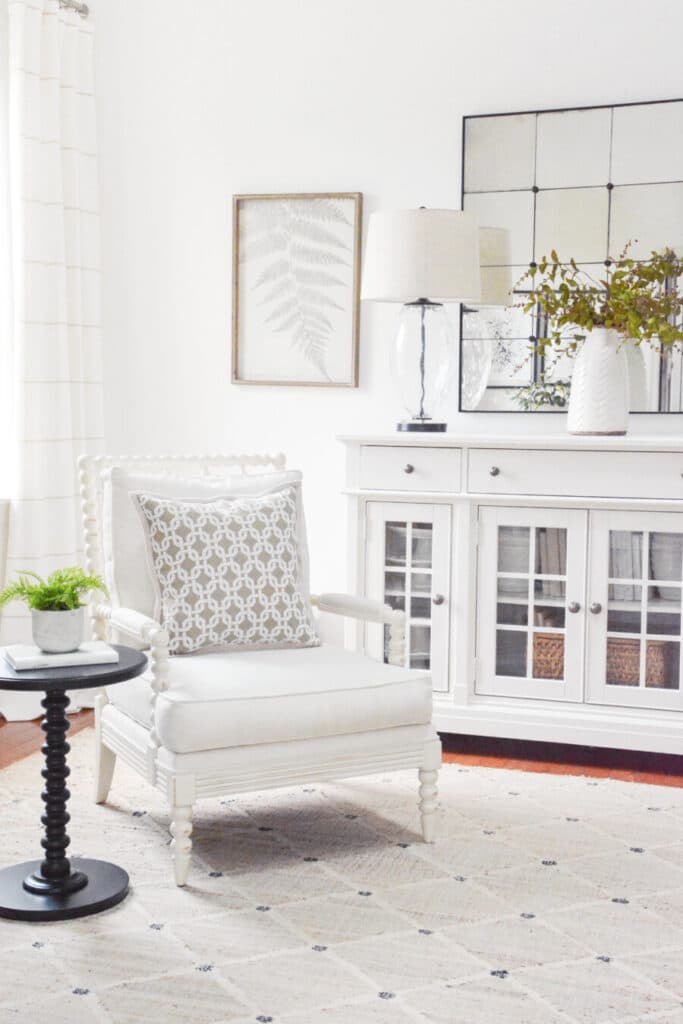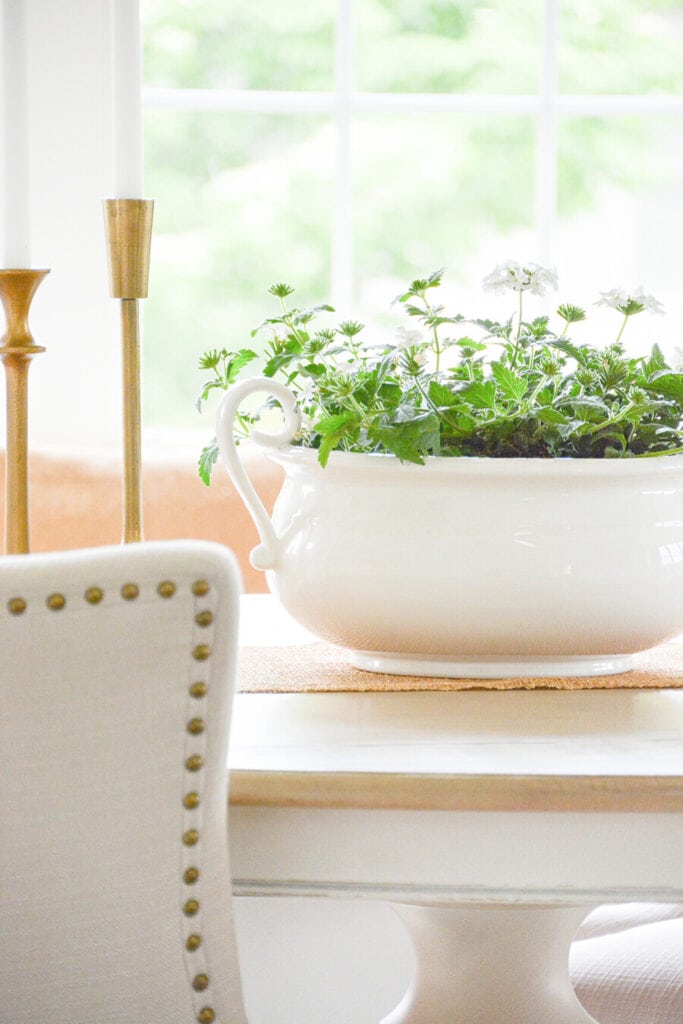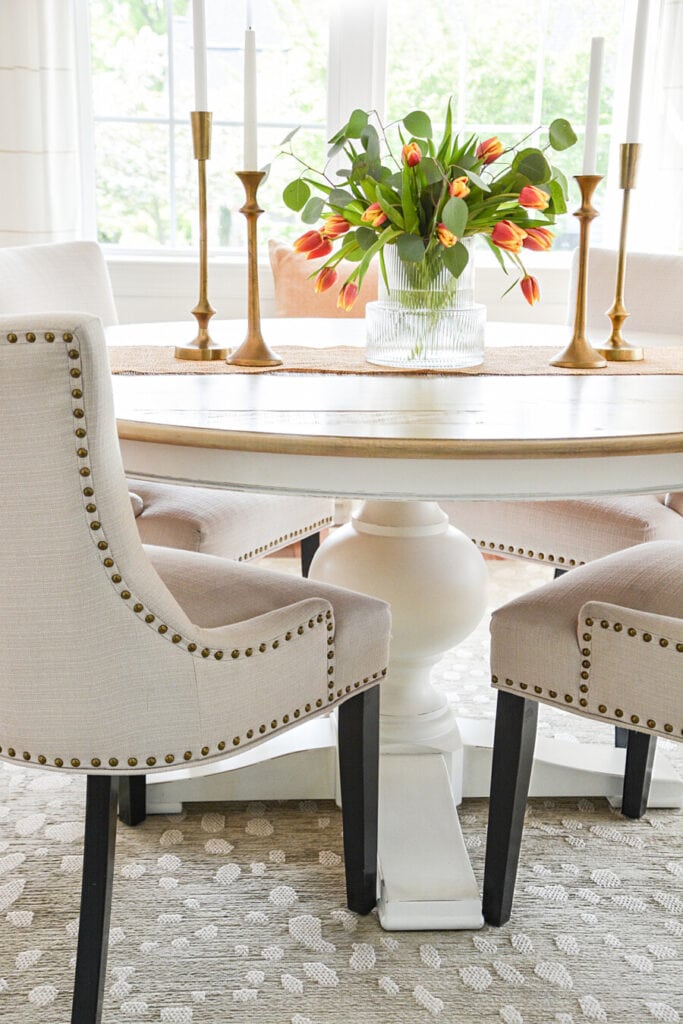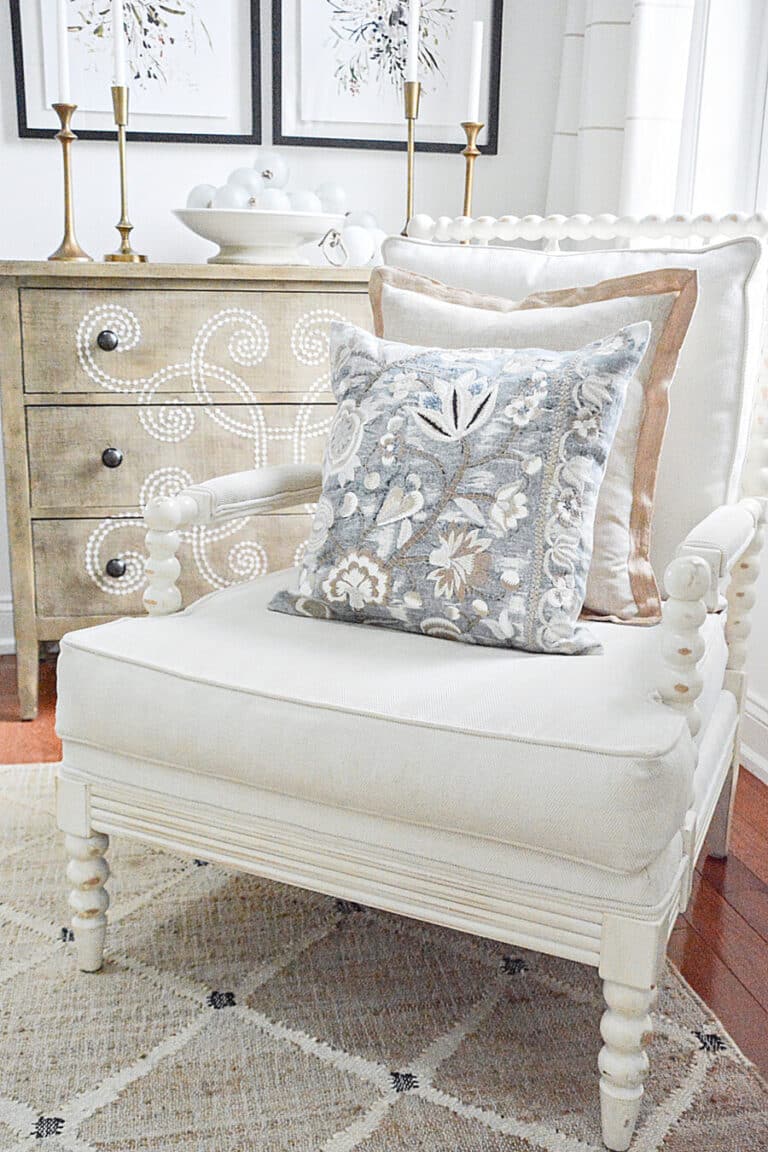7 Designer Tips For Decorating With Neutrals
Is the thought of creating a bland or boring space keeping you from using neutrals to decorate your home? Neutrals are classic and beautiful. In this post, get designer secrets for decorating with neutrals that strike the right balance of visual interest and harmony in any space.
One thing I love about neutral rooms is how effortless they look! However, looks can be deceiving! Behind the scene, a room with a neutral color palette is most often carefully thought out using tried and true interior decorating concepts! Here are 7 interior designer secrets to help you create a neutral room that is attractive, interesting, and balanced.
Affiliate links included. See our Discloser Policy. As an Amazon Associate, I earn from qualifying purchases.
I discovered the beauty and versatility of decorating with neutrals about a decade ago and still love neutrals as much today as I did then. Using these 7 tips below, I’ve been able to decorate and curate a home that is perfect for me. I hope you will use them in your home too. Let’s decorate with beautiful neutrals.
Pair Neutral Colors With Texture
One of the keys to successfully decorating with neutrals is to incorporate various textures into your design space.
Experiment with a mix of smooth, rough, and patterned fabrics to visual interest in your space.
In a neutral room where the color palette is minimal, introducing textural elements can prevent a room from feeling flat and uninteresting. Layer textural furnishings to create depth, contrast, and visual interest, making the room more attractive.
Think of using items in neutral home decor that are nubby, soft, fluffy, basketweave, shiny, rough, gritty, bumpy, wooly, and tone-on-tone. These are just some of the words that describe textures that mix well with neutral tones in a room.
Here are a few ways to add lots of texture to neutral decor…
- natural fiber rugs
- baskets
- nubby pillows and throws
- texture on furniture
- linen/burlap and patterned curtains
- woven rugs
- fringe
- rough hewn beams
- clay or potter lamps
- marble countertops
Mix and match metal finishes in a neutral space.
Different metal finishes bring out the best in a neutral space. Using different finishes is essential when decorating a neutral room because they can add another layer of visual interest and a touch of luxury.
Layering textures create a cozy and inviting atmosphere that you’ll love living in.
Take Advantage Of Architectural Elements
Great shapes and architectural detail get noticed in a room with a neutral color palette, bringing a room to life.
Architectural details such as moldings, trim work, and paneling can bring character and visual interest to a neutral room. These details create depth and texture on walls, ceilings, and other architectural elements, enhancing the overall aesthetics of the space.
Here are popular examples of architectural details that can be added to a neutral room:
- Crown molding: Crown molding is a classic architectural detail that adds elegance and sophistication to a room. It creates a lovely finished look in a room.
- Wainscoting: Wainscoting is a decorative wall treatment that involves paneling the lower portion of the wall. It can be made of wood, tile, or other materials and adds texture and visual interest to the room. Classically, wainscoting is painted white.
- Ceiling beams: Exposed ceiling beams can add a rustic or industrial charm to a neutral room. Whether real structural or decorative faux beams, they create architectural interest and draw the eye upward, making the space feel more expansive.
- Archways: Incorporating arched doorways or windows can bring architectural elegance to a neutral room. Arches provide a soft and graceful transition between spaces and can be a focal point themselves, especially if they are accented with decorative moldings or trim.
- Decorative columns: Columns can be used to divide spaces, provide structural support, or simply serve as decorative elements.
- Paneling: Installing paneling on walls, particularly in the form of shiplap, beadboard, or board and batten, can bring texture and visual interest to a neutral room. Paneling can be painted in a complementary or contrasting color to create a focal point or a statement wall.
- Fireplace mantel: A well-designed fireplace mantel can be a striking architectural feature in a neutral room. Whether it’s made of stone, wood, or another material, a mantel provides a focal point and can be decorated to work with your style and the season at hand.
- Staircase details: Enhancing the staircase with architectural details like ornate balusters, newel posts, or handrails can transform it into a focal point of the room. A staircase can add interest and detail to the space while maintaining a neutral color palette.
Use Different Neutral Tints And Shades
There are almost an unlimited number of neutral tints and shades that play nicely together! So it’s easy to use ones that will enhance the overall look of your space.
Multiple neutral hues in a room add depth and dimension. By using various shades of neutrals, such as different tones of beige, gray, or taupe, you can create a room that is visually attractive and prevent it from feeling flat or monotonous.
Neutrals naturally work well together, allowing you to create subtle contrasts within the room. These contrasts can be achieved by incorporating lighter (tints) and darker (shades) neutrals into a space. The result is a visually appealing space in which all the neutral colors work together.
Warm And Cool Undertones In Neutrals
Undertones are one of the most important things to understand and use when decorating any room, neutral or otherwise.
Undertones are secondary colors that are subtly present in any color. And they affect the dominant color in many ways. Primarily making the color warm or cool. Undertones include warm colors (red, yellow, orange), cool colors (blue, green, purple), and neutral colors (gray, beige, brown). Here’s a brief explanation of each undertone:
Understanding the difference between warm neutral undertones and cool neutral undertones can help you create a cohesive color palette that works together to create something visually attractive.
To help you, here is an overview of warm and cool undertones:
Warm Undertones:
- Colors with warm undertones are associated with red, yellow, and orange hues.
- Warm undertones evoke a sense of warmth and relaxation.
- Examples of warm undertones include creamy whites, beige, golden yellows, peach, coral, pink, earthy browns, and brick red.
- Warm colors can create a cozy and inviting atmosphere.
Cool Undertones:
- Colors with cool undertones are associated with blue, green, and purple hues.
- Cool colors tend to evoke a sense of calmness, tranquility, and serenity.
- Examples of cool undertones include icy whites, gray, light blue, lavender, mint green, and soft lilac.
- Cool colors can create a soothing and crisp atmosphere.
Include warm and cool colors in a neutral color scheme. Mixing warm and cool undertones can create visual contrast and interest, but it’s important to maintain a sense of balance.
Decide whether you want a predominantly warm or cool color scheme. Having one main undertone, either warm or cool, will help maintain a consistent look and feel in a space. Use accent neutrals in the opposite undertone to balance a room and add contrast to it. For instance, if you have a predominantly warm color scheme, adding cool accents or accessories in small doses can give a room visual interest and prevent the space from feeling too flat. Use the 80-20 rule.
I use a simple decorating formula to create a neutral room that is interesting, attractive, and has depth. Using a combination of 80% warm neutrals and 20% cool neutrals in a room can create a visually interesting and balanced color scheme.

Undertones are either warm or cool. When decorating, use 80% of one undertone and 20% of the other for a balanced and inviting looking space.
You might like to read Can You Mix Warm And Cool Colors In Decor.
Layering Decor
There are three primary ways adding light layers will enhance a room with a neutral color palette.
First, adding light layers of decor is very important when working with a neutral room’s color palette. It’s all about creating depth and dimension! By incorporating different textures, patterns, and materials, you can make the space feel more lively and interesting and guards against a room looking boring.
Second, achieve visual balance in a neutral room by incorporating light layers of decor. For instance, consider adding a camel-colored pillow to an off-white chair in a neutral living room. Or add a nubby runner and place brass candlesticks on a dining table in a neutral dining room. These subtle layers add beauty and interest to a space without overwhelming it. However, be cautious not to overdo it with too many neutral layers, as this can lead to a cluttered and busy-looking room.
And third, adding layers of decor is a chance to showcase your personal style and make the room my own. Choosing pieces that reflect your personality and interests brings warmth and character to a space. It’s those personal touches that make a room so interesting.
Pop Of Color
Adding a pop of color to a neutral room can be transformative! A pop of color in a neutral room can be as simple as adding a vase of orange flowers to a neutral space or adding a colorful chair that adds tension to a neutral room.
Adding an unexpected color in an otherwise neutral space creates a striking contrast against the neutral backdrop and instantly creates a focal point that our eyes are drawn to. Color acts as a visual anchor in the room, demanding our attention and making a statement.
Choose a color that reflects your personal style. Adding a pop of color that reflects who you are will infuse a neutral room with your personality.
Add A Bit Of Drama
Just a little bit of drama is exciting! In life and in the way we decorate our homes.
A neutral space gets a little more interesting by adding something dramatic to it. However, it’s important to strike a balance and not overdo it with too many dramatic elements. Just one will be enough.
Here are ways you can add a bit of drama to a neutral room:
- statement furniture
- accent wall
- dramatic lighting
- bold artwork
- dark colored accessory
- mirrors
- bold patterns
Choosing one dramatic element for a room with a neutral color scheme should create the desired dramatic effect while maintaining overall balance and harmony within the room.
Decorating with neutrals is a timeless and versatile approach to creating beauty in any space. By following these seven tips, you can master the art and science of neutral decor and achieve a cohesive balance of color, texture, and style.
Think of these tips as your toolbox of ideas and tried and true interior design concepts that will help you create a neutral room you will love.
Click Below To Get More Inspiration
Shop Neutral Decor
Shop some of my favorite neutral decor:
Frequently Asked Questions About Decorating With Neutrals
What is the best way to decorate with all neutrals?
Select a few neutral colors and incorporate their tints (lighter versions) and shades (darker versions) into your decor. This adds depth and dimension to the room. Additionally, choose a few accent colors that have opposite undertones to your main neutrals. These will add interest and a bit of decorative tension to your room.
Do all colors go with neutrals?
The short answer is yes. All colors go with neutrals. And neutral colors go with other neutral colors. To get more specific, there are some neutrals that don’t work with other colors as well because of their undertones.
How do I add color to neutral decor?
Use one pop of color in one or up to three places in a neutral room. This will draw your eye to this color and make the whole neutral room look interesting.
Related Posts
More About Neutrals
Learn interior design concepts broken down into easy-to-understand, doable processes you can use in your home.






















Yvonne, I am desperate. I have a painter arriving on July 3rd to paint my master bath/bedroom. Currently the bedroom is in a tan, the bathroom has tan going into it; then the rest is in a great teal color. I have white shutters, white columns, white baseboards and white crown molding. We just installed shiplap, vertical. He will be painting that white and it is behind our bed. I thought I wanted a creamy white throughout the room/bathroom. I have travertine floors and shower stalls that will not be removed. I have 2 black vanities with granite. Trying to update without tearing out. I tried Sonnet but it scares me it is too yellow with the travertine. Do you have another creamy white that you would recommend and right now all my moldings in my house are Swiss coffee Kelly Moore. Do I leave them that color in my bedroom, change them up with the creamy white, or is it all right to change those items but leave the rest of the house still Swiss Coffee. So very confused. Keeps me up at night. Thank you!
Hi Gayle, read this post: https://www.stonegableblog.com/can-you-mix-warm-and-cool-colors-in-decor/
It’s all about undertones. Swiss Coffee is a soft white with yellow undertones. This color looks good with other whites with warm undertones like Dove White. It is all right to use any color in bedrooms and bathrooms. Your home will still look cohesive. Go to a reputable paint store and have the consultant advise you. Paint your walls different colors of your favorite choices and look at them in every light for a few days. It will be easier for you to choose that way. Honestly, it is all about undertones. Hope this is helpful. Your home sounds beautiful. Have fun updating it.